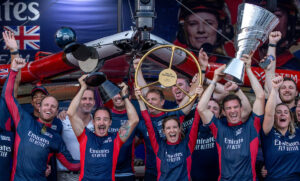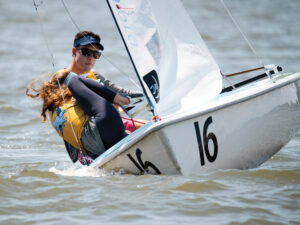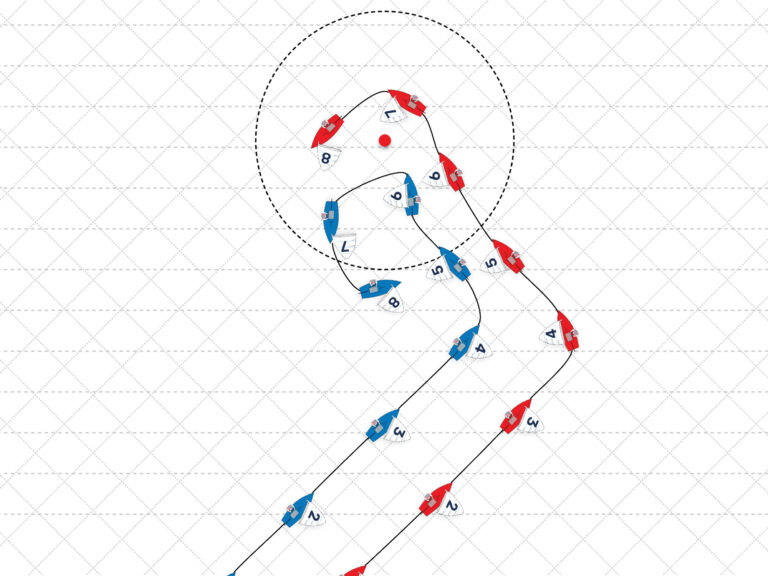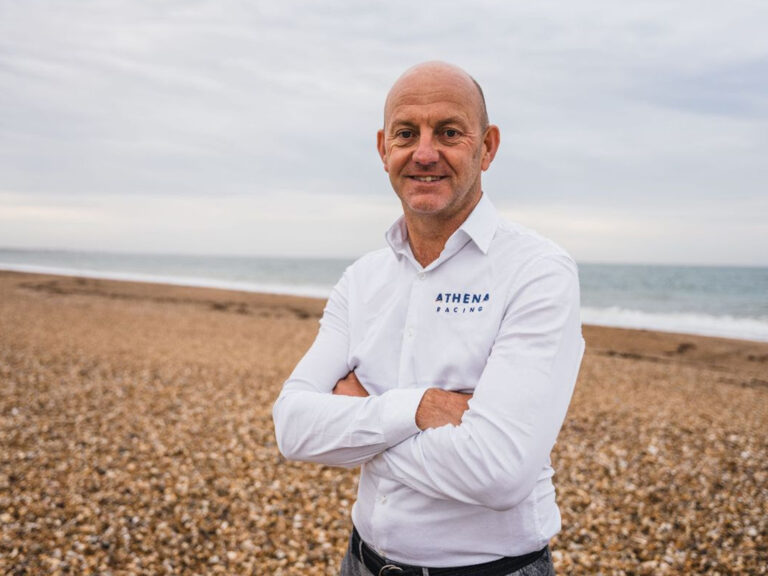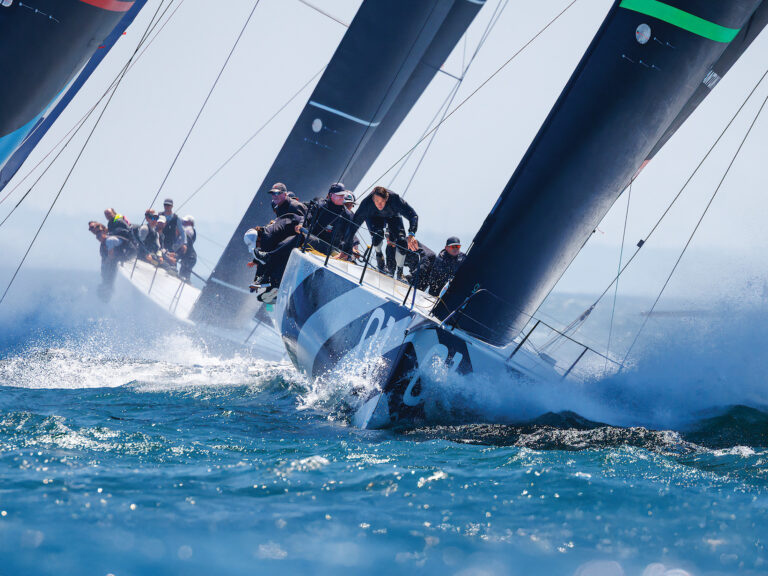
Dan Nerney/Rolex| |Olin Stephens (center) with author John Rousmaniere (left) on board Bolero, one of Stephens’ many famous design.| “I was lucky: I had a goal. As far back as I can remember I wanted to design fast boats.” The first two sentences of Olin Stephens’s autobiography, “All This and Sailing, Too,” summarize a lifetime’s vocation on the part of the most successful and influential designer of the 20th century. He was raised near New York City and, as a boy, was introduced to boats on family vacations at Cape Cod. Along with his father, Roderick, and younger brother, Roderick Jr. (called Rod), he learned to sail in a series of family-owned boats. Fascinated by sailing and its technology, the boys absorbed all they could from yachting magazines and their own experience and were encouraged and supported by their father.
Stephens entered the Massachusetts Institute of Technology in 1926, only to be forced to drop out during his freshman year due to illness. Throughout his life, although he was a pioneer in scientific yacht design, he would say that he regretted his lack of training in mathematics and engineering. Yet Stephens had aptitudes that suited his calling. “I started my career with the tools of observation and intuition to which quantitative analysis has been gradually added,” he wrote in his autobiography. “Whenever possible I studied lines and tried to see the way shape was coupled to performance.”
By 1926 he was sailing regularly at Larchmont Yacht Club in Six Meters, a restricted-design keel boat of about 34 feet LOA and the hot racing class of the day with top-flight sailor-designers like Clinton Crane and Sherman Hoyt. By 1928 he was working at a drafting table at home and, with the help of Norman L. Skene’s manual “The Elements of Yacht Design,” was teaching himself how to draw plans.
Stephens’s on-the-water observations of Six Meters confirmed the value of that rule of thumb. His first published design, a Six, appeared in the January 1928 Yachting with these comments by the young designer:”In any design the most important factors of speed seem to be long sailing lines and large sail area, with moderate displacement and small wetted surface. Then comes beauty, by which is meant clean, fair, pleasing lines. Though per se beauty is not a factor of speed, the easiest boats to look at seem the easiest to drive.”
To this equation he added stability due to considerable external ballast. Many older designers of offshore boats placed the lead ballast in the bilge in order to ease the boat’s motion through a seaway. Stephens preferred it deep in the keel, where Six Meters and other modern racing boats had it, in order to provide stability and sail-carrying ability for good upwind performance.
After working as a draftsman for Henry J. Gielow, who specialized in large power boats, and Philip Rhodes, Stephens in 1929 went into partnership with Drake Sparkman, a successful yacht broker, to form Sparkman & Stephens Inc. (S&S). The aggressive Sparkman was the salesman; Stephens, by nature a shy man, ran the design office. Their first project was a 21-foot LOA keel boat for junior sailing on Long Island Sound called the Sound Junior Class, later renamed the Manhasset Bay One Design (it is still sailing more than 70 years later). Then came a small cruising boat for his father and several Six Meters.
In 1928 he raced to Bermuda with John Alden in Malabar IX, and, after the finish, the 20-year-old swam from boat to boat to talk to crews and explore design features as his back blistered in the sun. After his grandfather sold the family coal business in 1929, his father commissioned S&S design Number 4, the 52-foot yawl Dorade. Her concept was much closer to a Six Meter than a Malabar. She had a tall Bermudian rig, balanced ends, narrow beam, lead ballast deep in the keel and lightweight, sophisticated construction (with steam-bent rather than sawn frames). Dorade was built at the Minneford Yard on City Island, N.Y., under the supervision of young Rod Stephens, who developed an efficient deck layout and a new type of deck ventilator (the Dorade vent) with a baffle that separated incoming air from spray. In 1931 she won the transatlantic race to England against many larger boats by two days on elapsed time and also won a rough Fastnet Race. When they returned to New York, the Stephenses were given a ticker-tape parade up Broadway. Thinking Dorade too narrow and tender, when Stephens had the opportunity to design another ocean racer in 1934 he increased the beam by two feet and the result was Stormy Weather, which he regarded as the better boat. These two boats transformed the design of offshore sailing yachts.
In the meantime Olin Stephens was playing an important role in the transition of yacht design from an art to a science with artistic disciplines. Scientific yacht design, using experiments and quantification of performance, came about because of his work with Kenneth S. M. Davidson of the Stevens Institute of Technology, in Hoboken, N.J. to develop a method for evaluating a design by towing models in water tanks.
It was soon used to help design an America’s Cup winner. Stephens first became involved with the America’s Cup in 1934 when he served in the afterguard of the unsuccessful defense candidate Weetamoe, designed by Clinton Crane. In 1936 Harold S. “Mike” Vanderbilt, who had defended the Cup in 1930 and 1934, brought Stephens together with W. Starling Burgess as a design team. Out of a series of tests of models, some of Burgess’s design and some of Stephens’s, came the great J-Class cutter Ranger, which dominated the 1937 America’s Cup season. She was one of the most successful racing boats of all time. When the work began, the two designers agreed to keep secret the identity of the one who produced the most successful model. After Burgess’s death, Vanderbilt suggested publicly that the credit for Ranger should go to Stephens. Stephens corrected him in a letter published in Yachting saying that Ranger was largely Burgess’s product.
Throughout the 1930’s Stephens continued to design Six Meters culminating in the very fast Goose and her near sister Llanoria, winner of Olympic gold medals in 1948 and 1952. He also designed 12-Metres and many cruiser-racers like the New York 32 class; Brilliant, a heavy schooner now owned by the Mystic Seaport Museum; the Dutch Zeearend; and the 72-foot yawl Baruna, which after World War II enjoyed famously close racing with another S&S-designed 72-footer, Bolero, in which Stephens sailed as a watch captain.
After the war, Stephens’s work expanded internationally, and S&S-designed ocean racers with different shapes won in Britain and Europe as in America. The Royal Ocean Racing Rule in Britain was encouraging relatively narrow, deep-bodied keel boats. The major championships under the Royal Ocean Racing Club rating rule, including the Admiral’s Cup and One-Ton Cup, were regularly won by S&S boats. In America, the Cruising Club of America rule over several years (1955-60) produced beamy centerboarders that also did well in ocean races. While Stephens designed centerboarders, he was not especially enamored of the type because of its relatively low stability. Nevertheless, his name is closely linked with centerboarders because of Carleton Mitchell’s 38-foot yawl Finisterre, which, beautifully prepared and brilliantly sailed by her owner and his crack crew, won three straight Bermuda Races (1956, 1958 and 1960). In time, the Cruising Club of America Rating Rule was adjusted to encourage narrower boats. In the late 1960s Stephens helped bring about the first international measurement rule, the International Offshore Rule (IOR). He later served as chairman of the rule’s International Technical Committee and played an important role in the development of the International Measurement System (IMS).
One of Stephens’s concerns was the seaworthiness of contemporary boats, many of which he thought too beamy, high-sided, light and unstable. After the 1979 Fastnet Race storm left a trail of capsized boats and 15 dead, Stephens wrote the shocking statement, “Some modern ocean racers, and the cruising boats derived from them, are dangerous to their crews.” In the early 1980s he helped direct a sophisticated study of the causes of capsizes by keel boats that was co-sponsored by the United States Yacht Racing Union and the Society of Naval Architects and Marine Engineers. Out of this work came several reports and a book, “Desirable and Undesirable Characteristics of Offshore Yachts,” to which Stephens contributed two articles.
All this time Stephens was producing successful racing boats, including the winners of a total of eight of the nine America’s Cup matches between 1937 and 1980. Other than Ranger, the most remarkable of these boats was Intrepid, the defender in 1967 and, after alterations by Britton Chance Jr., again in 1970. She had a rudder separate from her keel to reduce wetted surface and improve steering. The separate rudder was not new, but Stephens made it work on a number of increasingly large ocean racers (most notably Thomas Watson’s Palawan) in the mid-60’s before successfully using it on Intrepid.
While designing America’s Cup defenders and ocean racers, Stephens also produced a number of powerboats, motorsailers and cruising boats. Stephens also was active in the design of day-racing boats, the best known of which is the Lightning, a 19 foot three-person centerboarder designed in 1938 and raced worldwide. Other successful day boats included the 13.5 foot Blue Jay (a small version of the Lightning), the 11.5 foot Interclub Dinghy and the 30-foot Shields keel boat.
After Drake Sparkman’s death in 1964, Olin Stephens shouldered the firm’s administrative burden. His chief assistants included his brother Rod, who supervised much of the rigging design and construction, and Gil Wyland. Olin often raced in boats he designed and was in regular attendance at Newport during America’s Cup summers.Beginning in the 1930’s, Stephens nurtured a creative, independent life ashore. He studied art and painted, played the piano and read and traveled widely. He and his wife, Susie, lived in a New York suburb where they raised two sons. On his retirement in 1978 (after designing or supervising the design of more than 2,000 boats or classes), the Stephenses moved to northern New England. Stephens continued his varied life into his nineties. At nearby Dartmouth College he took courses in mathematics and helped teach a course on sailing for engineers. He developed his computer skills, worked with a firm on software for studying aerodynamics, advised America’s Cup syndicates and traveled often and far to technical conferences and meetings of international rating rules committees. When Dorade was returned to her original form by a dedicated new owner in Italy in 1998, Stephens happily flew over and joined her crew as she won two out of three races.
At the age of 90, Olin Stephens completed an insightful autobiography whose title – “All This and Sailing, Too” – neatly summarized his view of life. On the last page he wrote: “In all phases of my work I was conscious of the need for balance, and I did my best to find balance in both the long and the short view. Broadly I think I can say that I applied the principles of balance in design, in business and in the pleasures I enjoyed.”


